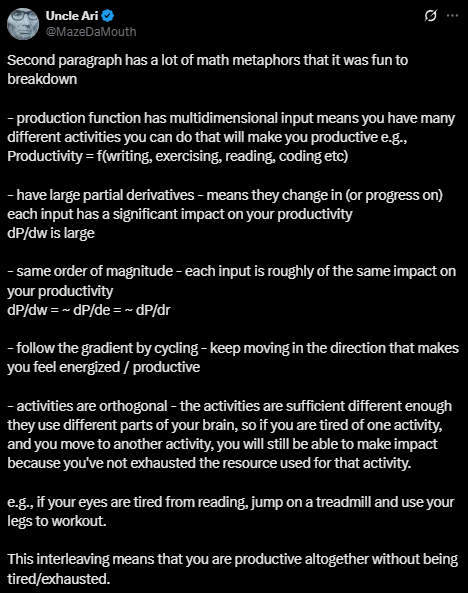The #1 Trick for Super-Productivity
... is interleaving a wide variety of productive work that you enjoy.
Want to get notified about new posts? Join the mailing list and follow on X/Twitter.
The #1 trick to super-productivity is interleaving a wide variety of productive work that you enjoy.
You get tired / bored / unproductive if you’re moving along one dimension for too long.
The solution is to get yourself in a situation where your production function has multidimensional input and all those inputs have large partial derivatives on the same order of magnitude.
You follow the gradient in that space by cycling between these component activities.
The activities are orthogonal, so whenever you start getting tired / bored / unproductive from moving along one dimension for too long, you just switch to a different activity, moving along a different dimension.
Caveat
Remember that “interleaving a variety of productive work” is different from running away from your problems. If you’ve hit a rut on some activity, and you’re switching tasks just to avoid dealing with that problem, and it’s been this way for a handful of cycles, then you’re past the limit of “taking a break to freshen up” and what you really need to do is bunker down and bust through the plateau.
The One Downside
The one downside to interleaving a wide variety of productive work that you enjoy is that sometimes there are pressing needs in multiple areas at the same time, and you don’t get the luxury of choosing to work on whatever you’re in the mood for, you don’t even get the luxury of focusing on a single thing for as long as you’d like.
If you can put your head down, go into monk mode, and shut all the other crap out from your brain for at least an hour or so each time before you have to switch, then I think you can prevent the context-switching friction from eating into your productivity too much, but it’s still frustrating because you don’t feel like you’re making as much progress as you want in any single direction.
Jason Roberts describes it well here:
- "Sometimes, or quite often even, my preempts are preempted by other preempts, and today, for instance, I'm at least 4 deep. Needless to say, this can be quite psychologically taxing due to the cognitive cost of switching context from one complex problem to another, not to mention the frustration of not being able to close the loop on those other issues that are actually actively burning fires. But that's just the reality of doing a startup and that's what I signed up for, so no complaining! Okay, maybe just a little."
But I think there’s also an upside in that sometimes it feels like a lot of open loops get closed at the same time. Almost like watching a handful of progress bars where it’s frustrating to watch any individual one because it’s moving so slow, but eventually you reach a euphoric window of time where it’s just bam, bam, bam, one bar completing right after another.
That said, the frequency of loops opening is always greater than the frequency of loops closing, things are almost always harder than you anticipate on them being, pretty often you when you think the progress is at 80% it turns out there’s something you forgot about and you’re really at 40%… I guess that’s why it’s so important to take a moment and celebrate the win when a loop gets closed.
Math Explanation
 x.com/MazeDaMouth/status/1980028693218234658
x.com/MazeDaMouth/status/1980028693218234658
Want to get notified about new posts? Join the mailing list and follow on X/Twitter.